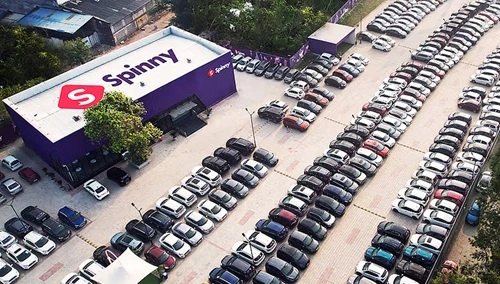At present, there are many platforms where you can buy and sell used cars in India, but when Spinny came along in 2015, it was a fresh start for many, and the platform was pretty good from the get-go. Over the years, though, they have evolved quite a lot, and right now, they have a bunch of things going on for them. So, for some reason, if you were feeling intrigued about Spinny’s business model, then just keep on reading because we’re about to get down to the ways in which Spinny makes money. Let’s get to it then.

| Company/Brand | Spinny |
| Establishment Year | 2015 |
| Headquarters | Gurugram, Haryana, India |
| Founder/Owner | Niraj Singh, Ramanshu Mahaur, Mohit Gupta |
| Industry | Used‑car retail (full‑stack) |
| Number of Employees | 1,001 to 5,000 (LinkedIn range) |
| Net Worth (Private valuation) | $1.7 to $1.8 billion (2025) |
| Total Revenue in 2025 | ₹4,657 crore |
What Is Spinny?
Spinny is a full-stack used-car platform that manages the entire customer journey-from car sourcing, inspection, and refurbishment to listing, financing, and doorstep delivery. These are the two most important factors that are being improved by the process because of the complete control from end to end.
The company was established in 2015 by Niraj Singh, Ramanshu Mahaur, and Mohit Gupta with the purpose of bridging the trust gap in the Indian used car market. They pretty much went on that route and became a big thing just a few years later.
Spinny’s Business Model Overall
Spinny operates an inventory-led model. What? Well, to put it in the simplest words possible, they do not just list cars as a marketplace would, but they instead buy the vehicles outright, carry out a 200-point inspection, refurbish them, and then sell to customers at fixed prices. In this way, Spinny has complete control over the vehicle and its margins.
The entire process that a user follows incorporates both online and offline interactions. For instance, customers can look at the cars using a website or an app, schedule a test drive at their home or at a Spinny branch, get the financing assistance that they need, complete the documentation, and, lastly, have the delivery carried out, you know, without the need to go to different places or negotiate the price.
How Spinny Makes Money?
1. Vehicle Sales Margin
Of course, Spinny’s major revenue source is essentially the classic “buy low and sell high” strategy. The company purchases second-hand cars, makes them market-ready, and sells them at a higher price. Plain and simple! For them, of course, this was 97.7% of the total operating revenue in FY25, like ₹4,553 crores out of ₹4,657 crores approximately.
2. Add-on Service Charges
Spinny has a price for the above three parts: car registration, insurance facilitation, and platform-related services. This is just extra income on the side for Spinny.
3. Financing Commissions
The company facilitates the connection of buyers to lending partners. And? Well, when this happens, Spinny is entitled to a fee or a commission when a buyer chooses a loan. Another extra income stream, you know?
4. Other Income
Non-operational income could be interest from deposits, investments in mutual funds or bonds, rental income, and valuation gains. This amounted to ₹96.84 crore in FY24 and ₹89 crore in FY25, thus giving the company some breathing room financially while it is scaling up.
Customer Experience & Operations
Spinny is a brand that reflects in its works the qualities of being transparent and putting the customer first. Each car is subjected to a rigorous 200-point check and refurbishment process, did you know that already? Like, buyers are also provided with comprehensive information beforehand, also they are also given the opportunity of trial drives at home or in a hub, along with support in documentation and home delivery, besides fixed pricing.
Additional advantages, such as warranty coverage and a money-back guarantee for five days, help to lower the anxiety of making a purchase.
Financial Performance
FY24
- Operating revenue: ₹3,725.02 crore
- Net loss: Around ₹590 crore (down approx 28% from the previous year)
- Other income: ₹96.84 crore
- Cost to earn ₹1 of revenue: ₹1.18
FY25
- Operating revenue: ₹4,657 crore (up 25%)
- Net loss: Around ₹424 crore
Signs of better cost control and stronger per-car profitability
Funding and Valuation
Spinny transformed into a unicorn in 2021 when it raised capital at a valuation that was in excess of $1.75 billion. That was a big thing! In 2025, the company got more money from the investors at almost the same valuation ($1.7 to $1.8 billion) with the likes of Accel and WestBridge as the investors, thus indicating that they are still very much confident in their business model and their growth overall.
What to Watch Going Forward
Spinny performs well when it is able to quickly sell its inventory, refurbish fast, and maintain good margins per car. They can actually go one step further and improve unit economics by growing the value-added services such as loans, insurance, and registration. That’s what they’re up to lately.



